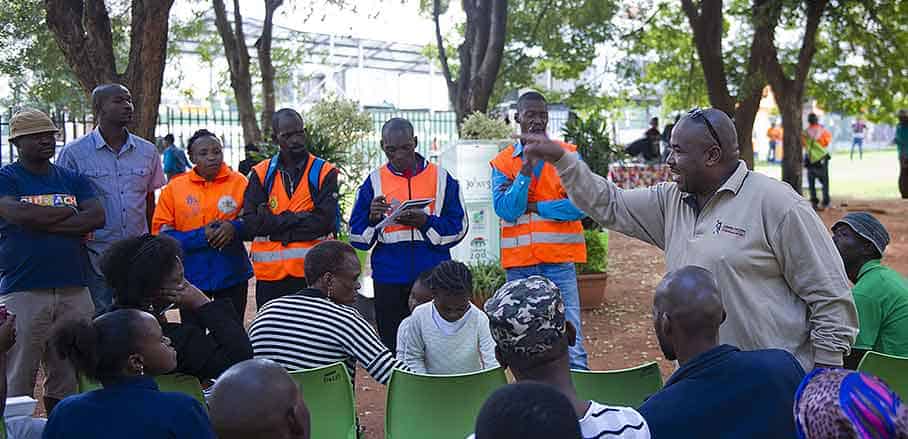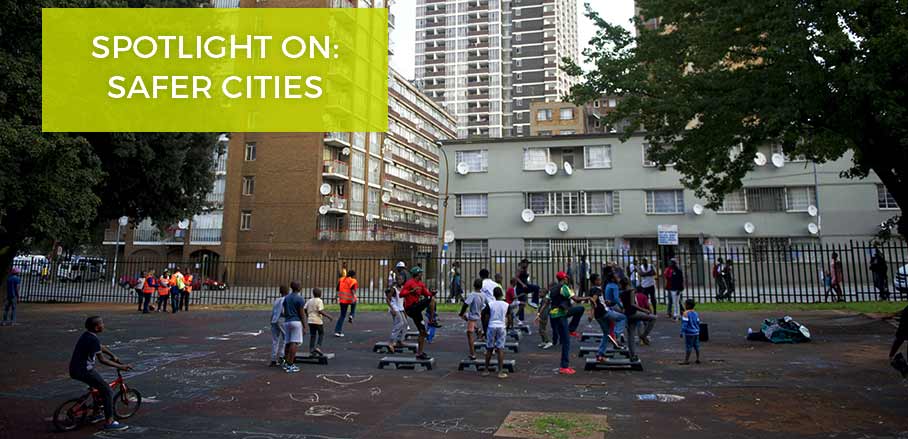Cities should be built for people – Let us start with creating safe public spaces for everyone
By Margo Weimers, Maximilian Vogt, Terence Smith, and Esther Wegner
In South Africa, historical shortcomings in city planning by the apartheid regime, rapid urbanisation, and a lack of economic opportunities have increased inequity and social exclusion. Faced with high rates of violence and crime, citizens are getting involved in enhancing safety in public spaces. Margo Weimers and her co-authors present an example from the city of Johannesburg.
When talking about shaping, developing and managing our cities and urban spaces we should keep one thing in mind: Cities will never stay the same! The concept of a city, a defined geographical space in which generations, beliefs, cultures and interests of thousands, sometimes millions, of people intersect and interact, is not a static notion. As people, technology and our priorities about the economy, environment, popular culture and globalisation change constantly; so too will the way we live and how we arrange our cities spatially.
Challenges and difficulties ranging from spatial planning, service delivery, urban decay, social ills, and economic development amongst others inevitably arise in densely populated urban areas. The task is not to shy away from addressing the constant need for adaptation but to tackle it in order to avoid challenges from accumulating to the point where they are no longer manageable.
Challenges for creating a safe city: The example of Johannesburg
In South Africa’s biggest city Johannesburg, a myriad of problems have manifested over many decades. The apartheid regime built and designed cities consisting of fragmented, inefficiently used and poorly functioning spaces. In addition, the first two decades of South Africa’s democracy saw significant changes as part of the Reconstruction and Development Programme (RDP), including mass delivery of low income housing mainly located at the periphery of the city, providing much needed accommodation. Unfortunately, this development process was not holistic and did not include the necessary social amenities, jobs and critical bulk infrastructure.
Additionally, rapid urbanisation, paired with a lack of economic opportunities amidst widespread poverty and growing unemployment, have exacerbated issues of spatial and economic inequity and the lack of social inclusion. This has also created a fertile ground for even more urban governance and development challenges. One of the most prominent amongst these is the problem of violence and crime.
Today, a young person growing up in Hillbrow, in the inner city of Johannesburg, or in Westbury, one of the low-income suburbs, or even in Diepsloot, an informal settlement near the city edge, faces a multitude of risk factors that could contribute to potentially drive her or him into a life of crime or violent behaviour. The lack of a permanent support base i.e. parents, older siblings or caregivers, no permanent home or residence and the exposure from a young age to violent crime, physical and social disorder as well as substance and drug abuse are often a reality for children and youth in many neighbourhoods of Johannesburg.
The impacts of deprivation weigh heavily on the development of a young person. Many children and teens may be forced into illicit and/or sexual activities to obtain money for independence, food, rent, or material gain i.e. clothes or drugs. Pro-social morals and values one might take for granted are often not taught and considered important due to the lack of a constant dependable positive adult or role model who verbalises what is right and wrong and demonstrates it through living the example1The financial demands and views of current society on modern life dictate that in most families both parents should work, compared to traditional male and female roles where fathers work and mothers have stayed at home to fulfil roles as care givers. The combination of extreme poverty, deprivation as well as social ills of substance abuse have affected families in many ways: one or both parents may have migrated to the city from a rural area or another country in search of work and the absence of one or both parents creates vulnerability particularly where there is no extended family to act as a financial and emotional safety net. One or more parents may abuse or neglect their children due to substance abuse; may participate in criminal and illicit activities to make some income; children may run away and live on the street due to the abuse/ neglect scenario or want for a better life and search for work.. Faced with these risk factors, many young people have little or no space to escape to – if home is not a protected space, the street might be the only (public) space where you can go. For many institutions such as schools, it is usually too late to effectively mitigate these risk factors.
Homicide rate six times higher than global average
Whilst there are several risk factors that may influence the youth trajectory regarding violence and crime, trends in crime statistics in South Africa provide a glimpse into possible future scenarios. Over the past five years, numbers of murder and attempted murder have been rising. While in 2011/2012, 15 554 people were killed nationwide, the number rose to 18 673 victims of murder in 2015/2016 (SAPS crime stats release September 2016). For South Africa, this results in a homicide rate of 31 in 2012 and 34 in 2016 per 100 000 people. This is about six times higher than the global average (6.2 murder per 100 000) (UNODC, Global Study on Homicide, 2013 and United Nations Office on Drugs and Crime database at https://data.unodc.org/).
While numbers vary between cities, they also vary highly within the same city. Johannesburg as a metropolitan municipality accounts for a homicide rate of 30 per 100 000 while some police stations within the municipality battle with rates above 70 (UCT Centre for Criminology for SACN 2016). In many urban areas, violence and crime have become part of daily life, with a devastating impact on social cohesion. Public spaces such as streets, parks or transport hubs, which should be spaces that facilitate social cohesion and inclusion, are actually heavily affected by crime and violence and perceived as unsafe.
Enhancing safety in public spaces: End Street North Park
After the Johannesburg City Parks and Zoo agency (JCPZ) conducted a survey that clearly showed that residents resist using public spaces in the inner city because of fear of violence and crime, the City of Johannesburg realised that it needed a different approach to the way parks are designed, developed and managed in order to enhance safety. In 2014, the city decided to pilot a new, integrated and inclusive approach to the design, implementation and management around one particular park that had been earmarked for upgrading: the End Street North Park at the border of Hillbrow and Doornfontein neighbourhoods.
The project recognises that not only a multitude of municipal departments and stakeholders, like Johannesburg City Parks and Zoo, the Department of Public Safety, the Johannesburg Development Agency (JDA) and the Department of Social Development, should work collaboratively in an integrated manner. Yet, most importantly, the local residents and park users had to be closely involved in planning and implementing processes from the very beginning. Only in this way can ownership by the community be achieved, making ongoing activation, responsive management and preservation of the new public space possible. Integrating more stakeholders and the local community also means that decision-making processes might take longer than previously anticipated or desired. But if solutions are to be sustainable, there is no alternative.
The End Street North Park used to be an unkempt, largely deserted space usually only used as a place to sleep by local homeless people, for burning waste by informal recyclers and for illegal activities such as drug abuse and selling or gambling. However, the active participation of the local community has led to residents from different segments of the population and city departments taking back the space and activating it through positive behaviour. Events such as “Meet your Neighbour” gatherings, reading corners for children, community safety assessments, theatre exercises and mobile health stations with free HIV testing now feature regularly in the new life of End Street Park. Local sports clubs like the Hillbrow Boxing Club organise training for children, youth and adults. A community stakeholder forum has been established that regularly addresses concerns of park users and residents and discusses these topics with different representatives from local government. Progressive, inclusive and sustainable solutions to challenges like homelessness and drug abuse are being discussed.
Although the pilot project is at a small scale, it shows the ample opportunities an integrated approach and real community participation can bring to urban development. For the residents, the upgrading and management of their park is the principal aim of the project. Furthermore, the steering committee team from JCPZ, the Johannesburg Public Safety Department and Johannesburg Development Agency hope to be able to use the lessons learned from this pilot for a citywide “safer parks and open spaces strategy”. Additionally, a set of guidelines for a participatory and sustainable approach in designing, implementing and managing safe, inclusive and accessible public open spaces is being developed.

Strategy building for inclusive public spaces
Recognising the fact that cities will always need to transform and adapt, we have to focus on how to deal with the resulting challenges, like that of unsafe public spaces, and the consequently extremely high restriction of freedom of movement due to fear. How can we turn this dangerous dynamic around, ensuring universal and safe access to public spaces in order to develop our cities into prosperous, liveable and sustainable spaces? Central to this will be the way in which different, normally competing, interests are negotiated and met and the way in which decision-makers and inhabitants communicate to and amongst each other. The identification and active participation of the relevant target groups in designing, developing and managing public spaces is thus key when it comes to the negotiation of varying interests.
The question of the extent to which, and how, the people who utilise urban public spaces are involved in the processes of shaping them will have implications in many different ways. Do we build spaces and places for, or with, people? Do we involve the community in decision-making or decide for them? It will determine whether spaces and places will be wanted and used and owned and managed by communities or not. Whether spaces and places will be active, cherished and desired or deserted, never used and fall prey to urban decay, grime and opportunistic crime. And in Johannesburg and South Africa today, it will certainly have implications on whether safety issues, especially for women and girls, will be taken into account when planning and designing urban environments.
It is the poorest of the poor who depend most on public spaces. If local governments argue that public spaces are a service that is free and for everyone, than it is critical that public spaces are accessible for everybody, especially the poor. They need to offer high quality standards in terms of design, implementation and after care management. Regular, structured engagement and first quick results are critical factors. It is especially important that young people need to be part of these processes since they are also one of the main targeted groups. Safety and violence prevention can only be a result of joint initiatives ensuring that every voice is heard. Demanding more policing in order to provide safety in public spaces should rather become the last resort and alternative.
Reality teaches us that challenges will always arise when multitudes of people move into and live in densely populated areas, being forced to share the existing limited space and resources. Contestations and conflicts are inevitable, and solutions are rarely simple. Yet, collaborative thinking and action combined with early interaction and involvement of the affected communities and particularly young people can help to rebuild our cities for more social cohesion, less inequality and better chances to mitigate risk factors for violence and crime.
